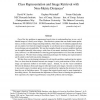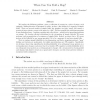4679 search results - page 16 / 936 » Modeling When Connections Are the Problem |
VLDB
2005
ACM
15 years 4 months ago
2005
ACM
Schemas evolve over time to accommodate the changes in the information they represent. Such evolution causes invalidation of various artifacts depending on the schemas, such as sc...
116
click to vote
ICCV
1998
IEEE
15 years 3 months ago
1998
IEEE
One of the key problems in appearance-based vision is understanding how to use a set of labeled images to classify new images. Classification systems that can model human performa...
WADS
2001
Springer
15 years 3 months ago
2001
Springer
We explore the following problem: given a collection of creases on a piece of paper, each assigned a folding direction of mountain or valley, is there a flat folding by a sequenc...
IJON
2002
14 years 11 months ago
2002
Epileptic seizures are characterized by repetitive synchronous neuronal bursting activity. To study external influences on this activity, a simple model of a chain loop of neurona...
103
click to vote
ATAL
2009
Springer
2009
Springer
Effective solutions for real-world Stackelberg games: when agents must deal with human uncertainties
15 years 6 months ago
How do we build multiagent algorithms for agent interactions with human adversaries? Stackelberg games are natural models for many important applications that involve human intera...


